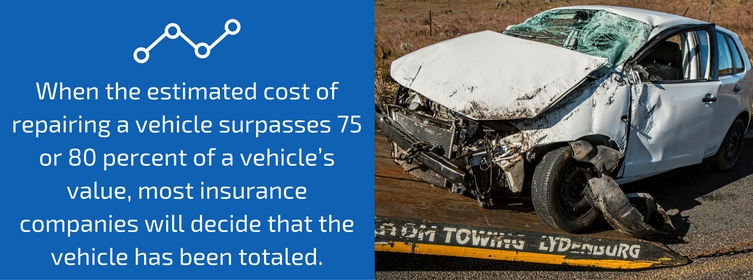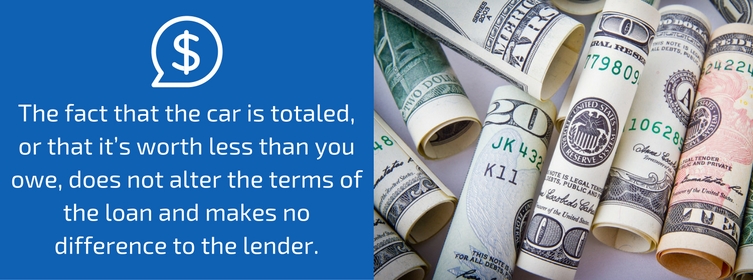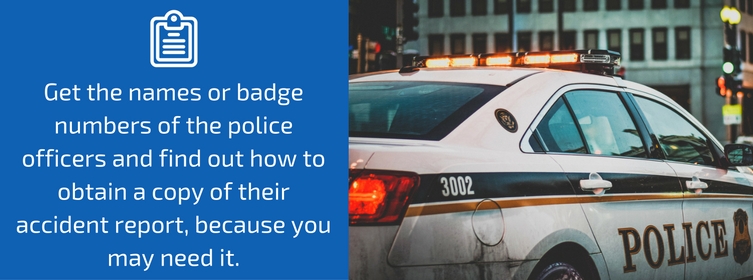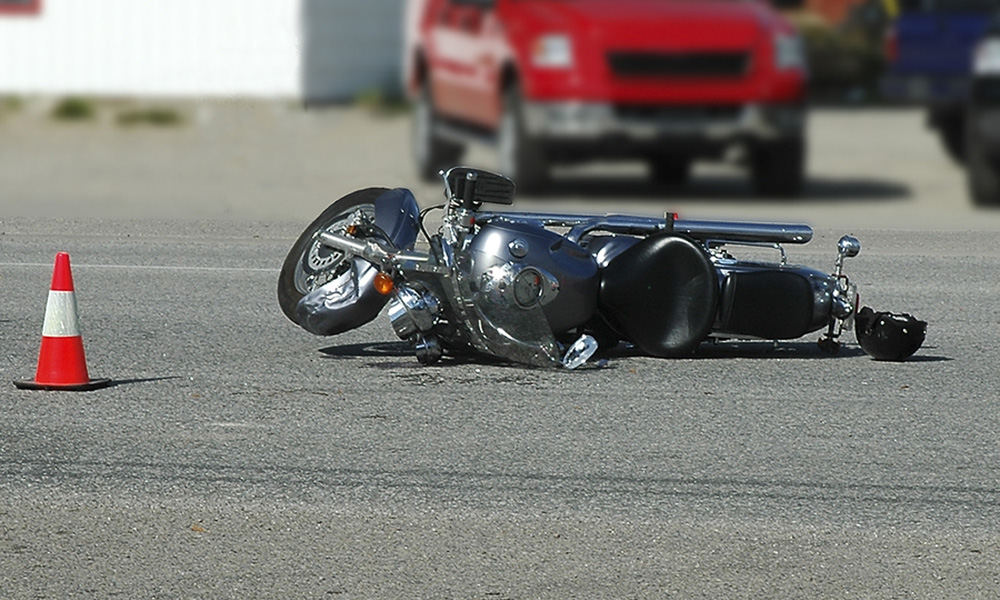Any traffic mishap is inevitably a hassle and an aggravation, but if your personal vehicle is totaled in a Southern California traffic collision, it can genuinely disrupt your life, at least temporarily. It can get even worse if you are still paying for the vehicle, because in that situation, for many of us, the ramifications of a total loss can be financially devastating. Let’s consider what your options and alternatives are if you still owe payments on a vehicle that an insurance company deems “totaled” after it’s been involved in a collision.
When the estimated cost of repairing a vehicle surpasses 75 or 80 percent of a vehicle’s value, most insurance companies will decide that the vehicle has been totaled. Each company has slightly different rules and percentages, and every situation will be different, but generally speaking, a total loss is declared if the repairs will exceed 80 percent of the vehicle’s worth. For example, if a car is valued at $5000 but the repairs will exceed $4000, most insurance companies will declare the car a total loss and reimburse the owner for the full $5000 value. But if the same vehicle can be repaired for less than $4000, then the repairs will usually be authorized.
If you are the owner of the totaled vehicle, that $5000 check (or whatever the amount is in your own case) will name you as the payee. But if you are still paying off a bank or a finance company for the loan that you purchased the vehicle with, the name of that bank or finance company will also be on that check. Insurance companies will ensure that a bank or any other lien holder is paid first when an insurance company pays for a total loss after a collision.
WHAT HAPPENS IF YOU OWE MORE ON A VEHICLE THAN ITS TOTAL VALUE?
It’s a fact of life. Automobiles depreciate, and some lose their value faster than others. With that in mind, a vehicle’s value is determined by the market rather by than the amount of the loan or by any other guidepost. Factors such as total mileage, the condition of the body, and the popularity of the model determine a vehicle’s real worth – what you could actually expect to sell it for. In the United States, the standard resource for determining a vehicle’s worth is the Kelley Blue Book, which lists the value of most models – in a range of conditions – going back a number of years.
In the best-case scenario – if there can be a “best” case following a total loss – the amount you receive from the insurance company will exceed the amount you still owe, and you’ll be able to put the difference toward buying another set of wheels. But if the amount you still owe exceeds the amount you receive from the insurance company, that can be a worst-case scenario. You are still obliged to make the monthly payments until the loan is satisfied. The fact that the car is totaled, or that it’s worth less than you owe, does not alter the terms of the loan and makes no difference to the lender.
WHAT IS GAP INSURANCE?
“Gap” insurance (it stands for “guaranteed asset protection”) is an optional insurance coverage for newer cars that can be added to your existing auto insurance policy. (The definition of “newer” varies among insurance companies.) If you have gap insurance coverage, it may pay for the difference between the balance of a loan due on the vehicle and what you receive from the insurance company if the vehicle is deemed a total loss after a traffic collision.
There are several steps you must take immediately if you are involved in a traffic crash in southern California. If anyone is injured in the accident, make sure that paramedics are called to the scene. And even if you don’t feel injured, have a doctor look at you as soon as possible after a traffic accident. Many serious personal injuries are not apparent immediately after a crash and may not emerge as medical problems for days or even weeks. Seeing a doctor at once is also imperative in case you need to file a personal injury claim at any time after the collision.
Exchange information with the other driver or drivers at the scene, including personal contact information, driver’s license details, and insurance policy information. If you have your cell phone, take photos of the accident scene and the vehicle damages. If the damage is anything more than a trivial scratch or dent, try to obtain names and contact information for anyone who was a witness, and call the police. Get the names or badge numbers of the police officers and find out how to obtain a copy of their accident report, because you may need it.
WHAT INFORMATION WILL YOUR AUTO INSURANCE AGENT NEED?
You should contact your auto insurance agent, and if you’ve been injured, you should also arrange to speak with a Pasadena personal injury attorney. You can do this when you arrive home from the accident scene or from the hospital, or even the next day, but do not procrastinate. Speak to your auto insurance agent even if you believe that the other driver was negligent and you are filing a personal injury claim, because you may have benefits through your own auto insurance that you may at some point need. When you speak with your agent, have the following information ready:
• the names, addresses, and telephone numbers of the other drivers involved in the collision
• the insurance policy details for those drivers
• the date, time, and location of the collision
• the name of the law enforcement agency that responded
If you’ve been injured in a Southern California traffic collision because the other driver was negligent, you are entitled by law to full reimbursement for your medical care for as long as you need it, your lost wages, and all of your other injury-related expenses. Having an experienced Pasadena personal injury attorney working on your behalf is imperative if you suffer a serious injury because another driver was negligent. But if you are not injured, and if the other driver’s insurance company is accepting liability, in many cases you may be able to pursue a basic accident claim without an attorney’s help.









